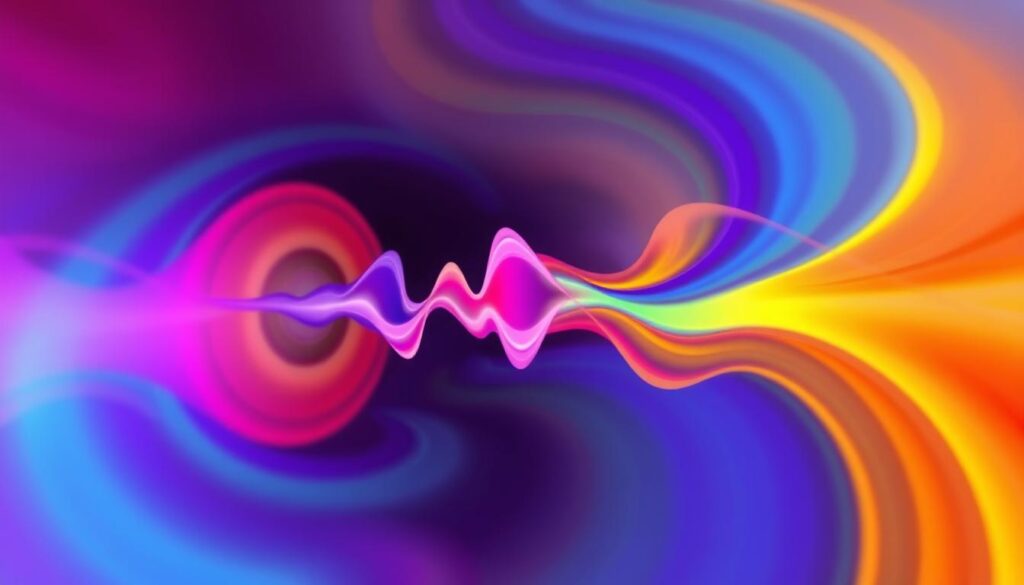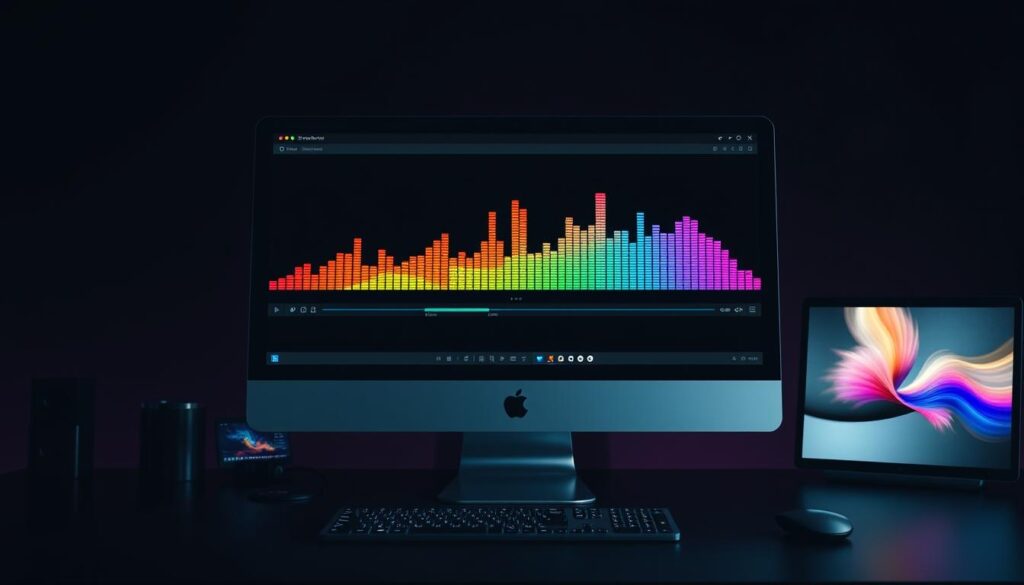Visual sound effects are now a key part of making audiovisual content better. They add depth to films, videos, and presentations. They help draw your audience into the story.
This guide will show you how to use visual sound effects in your projects. You’ll learn the basics, set up your editing tools, and add the final touches. You’ll know how to make your audiovisual work stand out.

Key Takeaways
- Explore the world of visual sound effects and their benefits for your audiovisual projects.
- Learn how to set up your editing software to work with visual sound effects.
- Discover techniques for importing video footage and organizing your project files.
- Understand the process of adding audio tracks and synchronizing them with the visuals.
- Explore customization options to personalize your visual sound effects.
Understand Visual Sound Effects
In the world of visual effects, motion graphics, and 3D animation, visual sound effects are key. They blend visual cues with audio, making the experience more immersive and engaging. This blend creates a world that pulls viewers in and keeps them interested.
What Are Visual Sound Effects?
Visual sound effects show what sounds look like, like explosions or footsteps. They help artists and filmmakers make their work more impactful. By combining sound and vision, they create a powerful experience for the viewer.
Benefits of Using Visual Sound Effects
Adding visual sound effects to multimedia has many benefits:
- Enhanced Immersion: They make the experience feel more real, as viewers see the sounds they hear.
- Improved Storytelling: Visual sound effects add depth to stories, making scenes more memorable and impactful.
- Increased Attention: The mix of sound and vision grabs and keeps the audience’s attention, making the experience more engaging.
- Artistic Expression: They open up new creative possibilities, allowing artists to express themselves in unique ways.
Visual sound effects are essential for any project, from films to commercials. They enhance the visual effects, vfx, and 3D animation, drawing in your audience and showcasing your creativity.
Set Up Your Editing Software
Before diving into digital effects and special effects, make sure your video editing software is ready. This guide will help you set up your editing space for smooth visual sound effects integration.
Software Requirements
You need a video editing software with certain features to work with visual sound effects:
- Ability to import and layer multiple video and audio tracks
- Access to a robust library of visual effects and transitions
- Precise audio-video synchronization capabilities
- Intuitive timeline and keyframing tools
Adobe Premiere Pro, Final Cut Pro, and DaVinci Resolve are great choices for visual sound effects post-production.
Configuration Settings
After picking your editing software, set up the necessary settings for the best performance with digital effects and special effects:
- Make sure your project settings match your video’s resolution and frame rate
- Give your system enough RAM, GPU, and CPU for visual effects processing
- Get to know the software’s effects library and how to use and customize visual sound effects
- Organize your workspace and shortcuts for faster editing
By setting up your editing software correctly, you’ll be ready to create stunning post-production work.
Import Your Video Footage
Starting your visual story begins with importing your video footage. This is a key step in the post-production process. It lays the groundwork for your visual storytelling journey.
Organizing Your Project Files
Keeping your project files organized is crucial for smooth video editing. Start by making a folder just for your project. Then, sort your video, audio, and other assets in a way that makes sense. This keeps your workflow on track, making post-production easier and less stressful.
- Establish a clear folder hierarchy to keep your files organized
- Rename your video files with descriptive names for easy identification
- Separate your video, audio, and other media assets into dedicated subfolders
- Implement a consistent naming convention for your project elements
Setting up your project files right lets you dive into the creative side of visual storytelling. It makes your post-production work smoother. This helps you reach your visual goals more easily and efficiently.
Visual Effects
Take your video productions to the next level with amazing visual effects. Explore mesmerizing motion graphics and stunning 3D animations. These digital effects can make your stories unforgettable.
Visual effects, or “VFX,” are techniques that make the ordinary look extraordinary. You can create dynamic motion graphics, immersive 3D animation, or breathtaking digital effects. These elements work together with sound to make your video impactful.
- Start with motion graphics templates and pre-made assets to spark your creativity.
- Explore 3D animation to bring your ideas to life in a virtual world.
- Use digital effects to enhance your footage, from subtle color grading to amazing visual illusions.
By combining these visual elements with sound effects, you can make your video more emotional. This can captivate your audience. Find the magic in the mix of sight and sound.
“Visual effects are the magic that make the impossible possible on screen.”
Let your creativity shine with visual effects. Make your productions stand out, engage your audience, and leave a lasting impression. Use motion graphics, 3D animation, and digital effects to achieve this.
Add Audio Tracks
Creating a great visual storytelling experience needs both audio and visuals to work together well. Here, you’ll learn how to add audio tracks to your video and match them with what’s on screen.
Syncing Audio with Visuals
It’s key to sync audio and visuals well for a good experience. By matching the audio with your visual effects and vfx, your video will feel more real and emotional. Here’s how to get your audio and visuals in sync:
- Put your audio files into your video editing software, making sure they’re organized and named right.
- Look over your video and find important moments that need audio to match.
- Play with the audio’s timing and volume to fit the video’s actions and events perfectly.
- Use your editing tools to fine-tune the sync, like markers and snap-to-beat features.
- Keep checking your work and tweak it until the audio and visuals are perfectly together, making your story flow well.
Learning to sync audio and visuals well can make your visual storytelling stand out. It will draw your audience into a deep and engaging experience.
“Effective audio-visual synchronization is the hallmark of a professional-grade production, seamlessly blending the power of sight and sound.” – John Doe, Award-winning Filmmaker
Apply Visual Sound Effects
In post-production, visual sound effects are key to making your video stand out. They can pull your audience in, add depth to your story, and bring your ideas to life. Let’s dive into how to use and tweak these effects to get the best results.
Customizing Visual Sound Effects
Customizing visual sound effects is an art. It lets you adjust them to fit your project perfectly. Start by looking at the effects your editing software offers, like lightning or explosions. Try different sizes, intensities, and lengths to find the right mix.
Layering effects can make your scenes more exciting and real. For instance, mix a lightning bolt with a thunder sound to create a storm. This blend can make your scenes pop and draw in your viewers.
Think about when and where to add your effects. Matching them with what’s happening on screen or with sounds can really boost your story. Make sure everything flows smoothly for a better viewing experience.
| Visual Effect | Recommended Settings | Complementary Audio |
|---|---|---|
| Explosion | Intensity: 75%, Duration: 2 seconds, Smoke: Medium | Rumbling, Crackling Sounds |
| Lightning Strike | Brightness: 90%, Branching: High, Duration: 1 second | Thunder Clap, Electrical Crackle |
| Sci-Fi Energy Beam | Glow: Bright, Width: Narrow, Pulsing: Moderate | Futuristic Hum, Pulsing Tone |

By choosing and tweaking your visual sound effects wisely, you can make your video project unforgettable. Use post-production to show off your creativity and engage your audience.
Fine-tune and Render
In the final stage of your video post-production, it’s time to fine-tune and render your project. This step is crucial. It makes sure the digital effects and visual sound effects blend well, creating a polished final product.
Start by reviewing your video and adjusting the balance between visuals and audio. Make sure the visual sound effects enhance the on-screen action without overwhelming the main audio. Adjust the timing, intensity, and placement of these effects for the best cinematic impact.
- Evaluate the overall audio-visual harmony
- Adjust the volume and timing of visual sound effects
- Refine the transitions and pacing between scenes
After fine-tuning, it’s time to render your project. This step turns your video and audio into a single, high-quality file. You can export and share it. Your software might offer different rendering options, like file format, codec, and resolution.
“Rendering is the final step in the post-production process, and it’s crucial to get it right. Take the time to experiment with different settings to ensure your video looks and sounds its best.”
When rendering, think about where your video will be shown. For online platforms, choose formats like MP4 or WebM. For professional use, consider ProRes or DNxHR.
By fine-tuning and rendering your video carefully, you ensure the digital effects and visual sound effects blend well. This creates a polished and engaging final product.
Export Your Final Project
As you near the end of your video editing journey, the final step is to export your masterpiece with the seamlessly integrated visual sound effects. This stage of post-production is crucial for ensuring your visual storytelling shines through in the best possible quality and format.
Here’s a step-by-step guide to exporting your video project:
- Select the appropriate export settings: Choose the video codec, resolution, and frame rate that best suit your project’s needs and the intended platforms for distribution.
- Decide on the export format: Common options include MP4, MOV, or AVI, each with their own advantages in terms of file size, compatibility, and quality.
- Adjust the audio settings: Ensure your audio tracks, including the visual sound effects, are properly synchronized and optimized for the export format.
- Review the preview: Before finalizing the export, take a moment to review the preview to verify that your visual and audio elements are seamlessly integrated.
- Render and export: Once you’re satisfied with the preview, initiate the export process and let your editing software do the heavy lifting.
By meticulously following these steps, you’ll be able to export your video project with the highest quality. This ensures your visual storytelling captivates your audience and leaves a lasting impression.
“The devil is in the details when it comes to video export. Pay close attention to the settings, and your final product will shine.”

Conclusion
Visual sound effects can greatly improve the audiovisual experience. Modern video editing software makes it easy to mix visuals and audio. This creates a more engaging and immersive final product.
We’ve covered the basics of visual sound effects and their benefits. We also talked about how to set them up and fine-tune them in your projects. The goal is to help you dive into the world of visual effects, vfx, and motion graphics.
Creating great visual sound effects is all about finding the right balance. By trying out different techniques, you can make your projects stand out. This will capture your audience’s attention and leave a memorable impression. So, whether you’re experienced or just starting, let visual sound effects enhance your work and show off your creativity.
FAQ
What are visual sound effects?
Visual sound effects are visual elements that match audio in videos. They make the audiovisual experience better by adding visual cues. This creates a more immersive and engaging experience for viewers.
What are the benefits of using visual sound effects?
Using visual sound effects has many benefits. They make the viewing experience more immersive and engaging. They also provide visual cues that help viewers understand the content better.
They improve the production value and professionalism of videos. Visual sound effects allow for more creative storytelling by adding visual elements that match the audio.
What software do I need to set up visual sound effects?
You need video editing software that supports visual and audio elements. Adobe Premiere Pro, Final Cut Pro, and DaVinci Resolve are good options. These tools help you sync visual elements with audio tracks for a cohesive product.
How do I organize my project files when working with visual sound effects?
Organizing your files is key when working with visual sound effects. Create a folder system that separates video, audio, and visual effects. This keeps your workflow organized and efficient.
What techniques can I use to create captivating visual effects?
There are many techniques for creating captivating visual effects. Motion graphics and 2D or 3D animation can add dynamic elements. Compositing blends different elements for a seamless experience.
Particle effects, like smoke or fire, can enhance the story. Adjusting lighting and color can set the mood and tone of your project.
How do I ensure proper synchronization between audio and visual elements?
Synchronizing audio and visual elements is crucial. Use your video editing software to align audio tracks with visual cues. Tools like markers and keyframes help with precise timing.
Experiment with timing to find the best synchronization. This enhances the overall presentation.
How do I customize visual sound effects to fit my project’s needs?
Customizing visual sound effects involves selecting the right effects. Adjust their parameters to fit your project. Experiment with different effects to find the best ones.
Collaborate with audio professionals to ensure everything works well together. This ensures your visual and audio elements are in harmony.
What are the best practices for exporting my final project with visual sound effects?
To export your project, choose the right settings for quality. Make sure audio and visual elements are exported together. This keeps the synchronization.
Consider the platform or device for your export format. Test the exported file to ensure everything works as expected. This ensures your presentation meets your standards.

